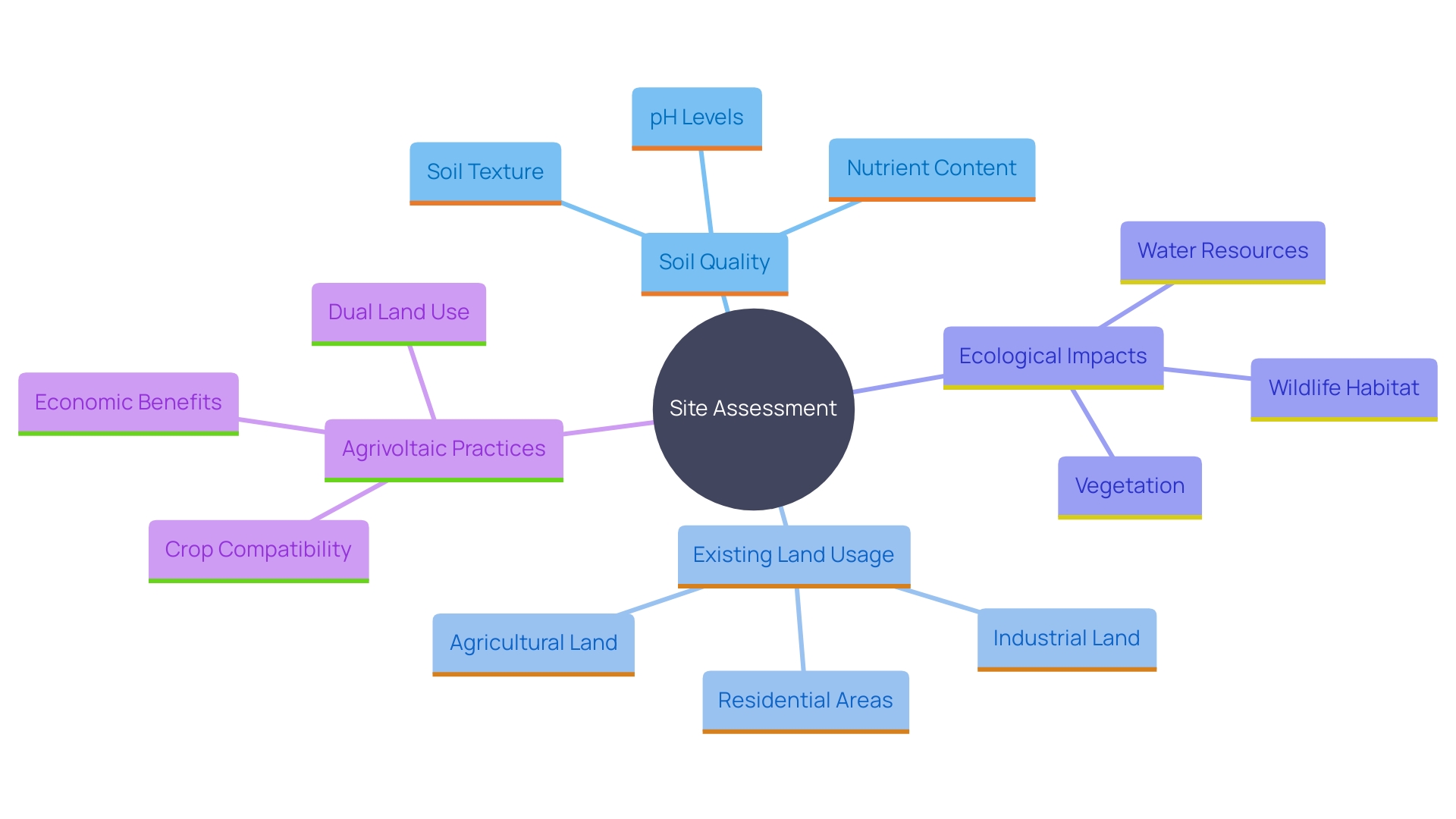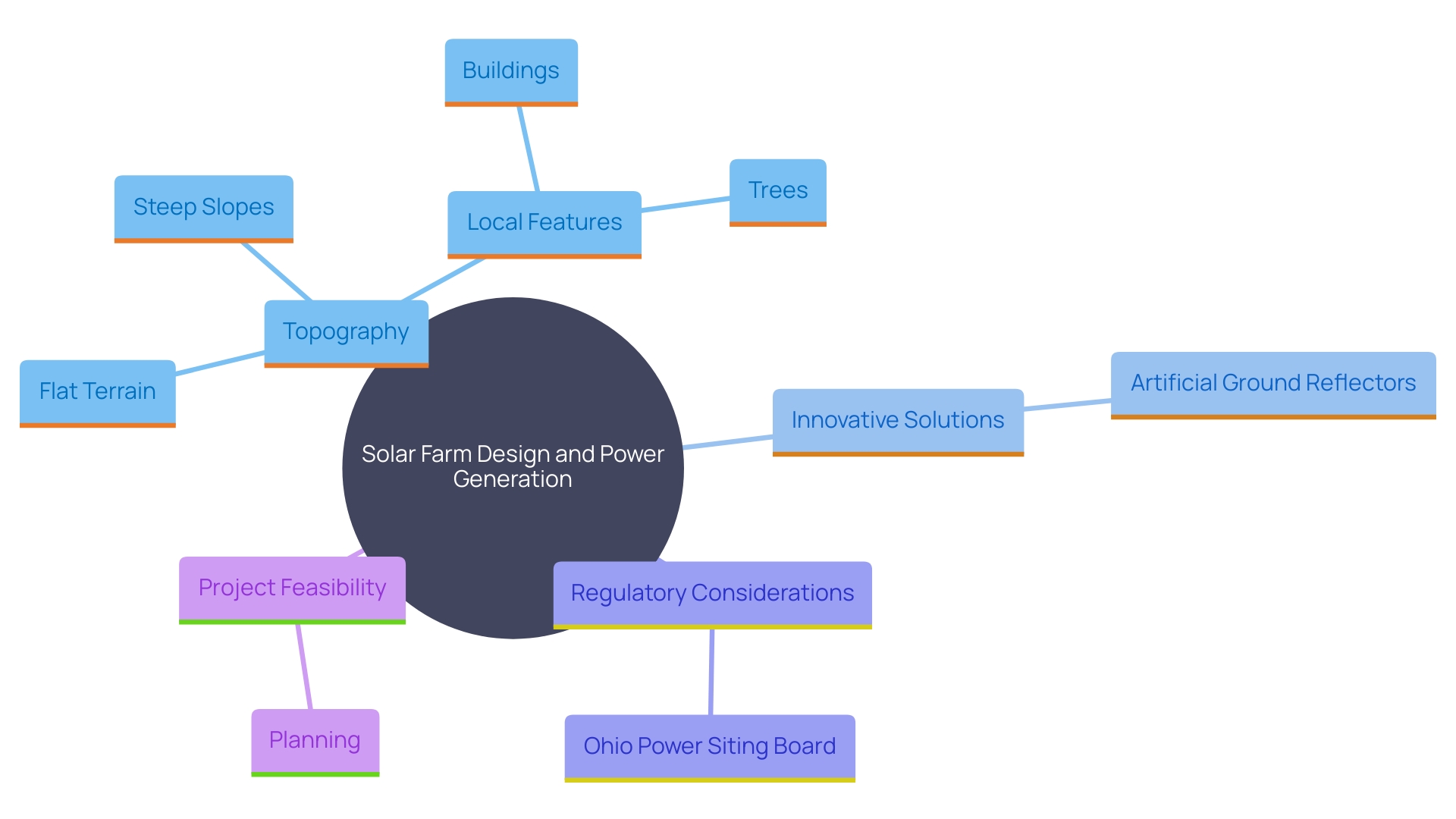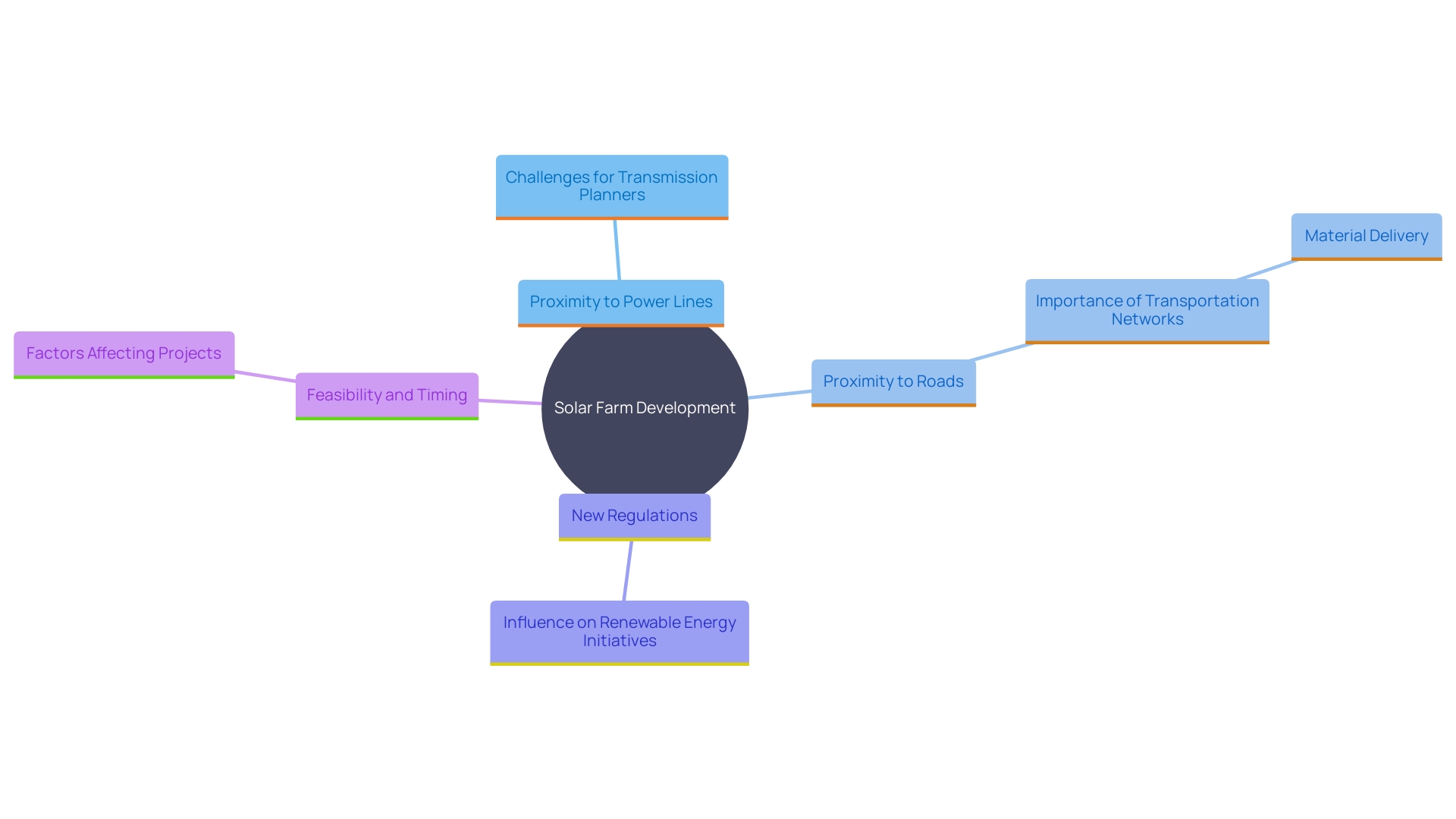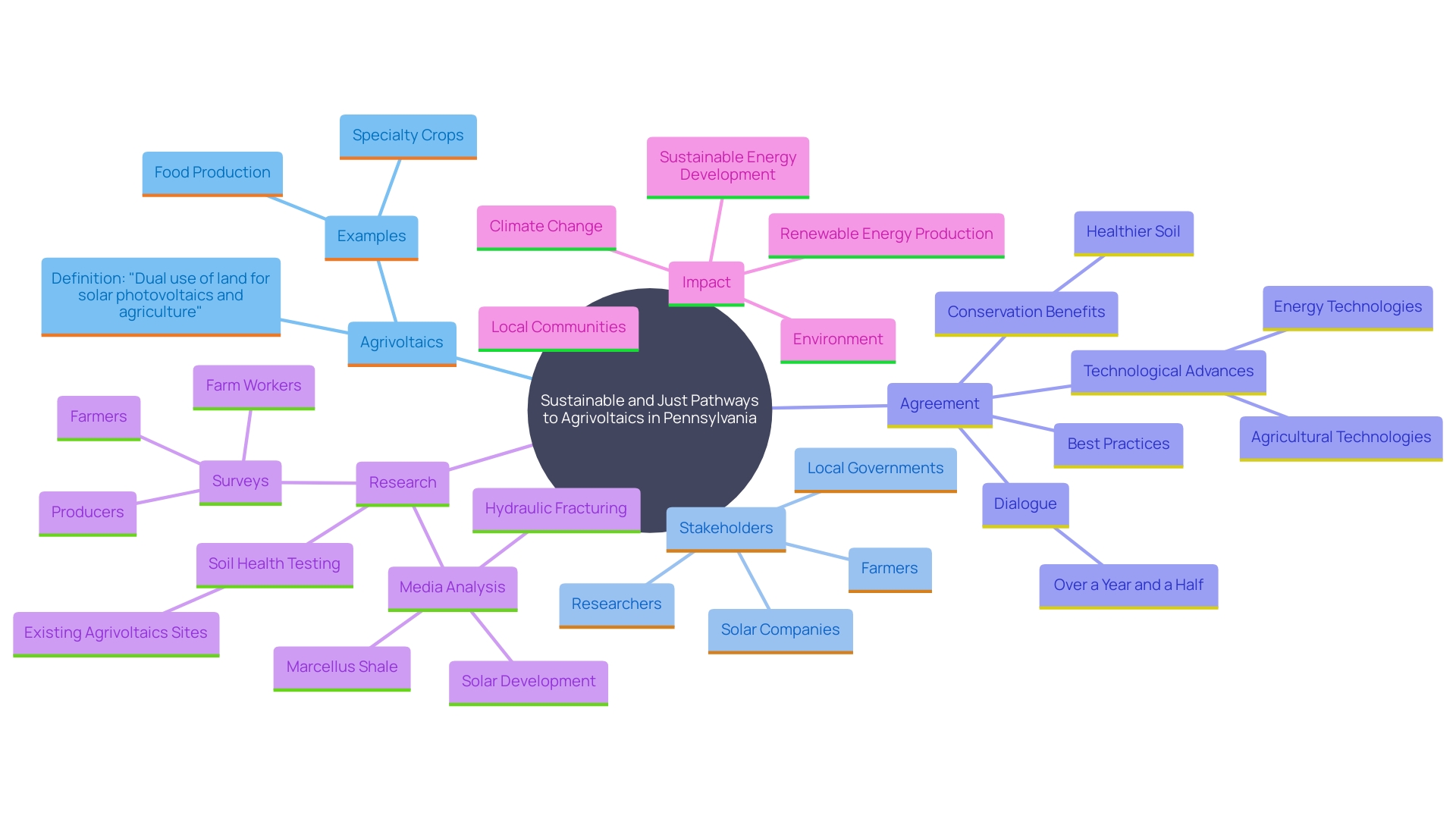Introduction
As the global demand for renewable energy continues to surge, solar farm development has emerged as a pivotal strategy in the transition towards sustainable energy sources. This article delves into the critical factors influencing solar farm land development, providing a comprehensive analysis of size and acreage considerations, land suitability, topography, infrastructure proximity, and regulatory frameworks. Understanding these elements is essential for optimizing land use and ensuring the successful implementation of solar energy projects.
Through detailed examination and authoritative insights, the discussion highlights the complexities and strategic measures necessary to navigate the multifaceted landscape of solar farm development, emphasizing the importance of thoughtful planning and collaboration among stakeholders.
Size and Acreage Considerations
The dimensions of a photovoltaic facility are crucial in ascertaining the area needed for its setup. Generally, a photovoltaic energy facility requires approximately 5 to 10 acres of area for each megawatt (MW) of installed capacity. This requirement can vary depending on the technology used, the configuration of the panels, and the particular power output aimed for. For example, larger installations can realize economies of scale, potentially decreasing the area required per MW. As the Solar Market Insight Report emphasizes, renewable power development has surged, with the US installing 6.5 GWdc of capacity in Q3 2023 alone, making up 48% of all new electricity-generating capacity. This increase highlights the significance of coordinating power production objectives with accessible territory to improve initiative effectiveness. Furthermore, the Ohio Power Siting Board (OPSB) plays an essential role in evaluating renewable energy initiatives to ensure they comply with environmental and regional planning standards, emphasizing the necessity for careful use of space in clean energy projects.

Land Suitability Factors
Assessing site suitability for photovoltaic farm development necessitates a thorough evaluation of various elements, such as soil quality, existing usage, and possible ecological effects. Areas with minimal vegetation and no significant ecological constraints are often ideal. For instance, repurposing previously disturbed lands such as brownfields or agricultural lands can enhance land use efficiency and sustainability. Thorough soil health evaluations are essential, as they guarantee that the selected location can sustain the required framework for power generation. Soil quality is paramount, with considerations such as nutrient levels, soil structure, and biodiversity playing pivotal roles. As stated by the Ohio Power Siting Board (OPSB), renewable energy initiatives must fulfill specific requirements, including reducing negative environmental effects and conforming to regional strategies for electrical grid growth. 'The execution of agrivoltaic initiatives, like those by Energy in Latin America, highlights the capability for merging photovoltaic installations with farming methods, thus tackling terrain utilization issues and fostering sustainable power advancement.'.

Topography and Landscape Considerations
The topography of the land is a crucial element in the design and power generation of solar farms. 'Ideally, flat or gently sloping terrain is preferred, as it facilitates optimal panel placement and maximizes sun exposure, which is essential for effective power generation.'. However, steep slopes or areas prone to erosion present challenges that require additional engineering solutions, consequently increasing project costs.
'Local landscape features, such as trees or buildings, also play a significant role as they can cast shadows, thereby affecting power generation.'. Careful site selection and meticulous layout planning are imperative to mitigate these issues. This is backed by the results from the University of Ottawa's SUNLAB, which showed that incorporating artificial ground reflectors into photovoltaic arrangements can significantly improve output and effectiveness. This approach not only enhances the financial feasibility of initiatives but also highlights the significance of creative solutions in maximizing sunlight power production.
Furthermore, the Ohio Power Siting Board (OPSB) requires a thorough evaluation procedure to guarantee that renewable energy initiatives satisfy rigorous environmental and economic standards. This includes minimizing adverse environmental impacts and ensuring compatibility with regional plans for expanding the electric power grid. Such regulatory frameworks emphasize the necessity for strategic planning and adherence to legal standards in the development of renewable energy initiatives.

Infrastructure Proximity and Interconnection
Proximity to existing infrastructure, such as power lines and roads, is crucial for the successful development of a solar farm. Sites located near transmission lines can facilitate easier interconnection to the grid, reducing costs and installation time. This is particularly important given the current challenges faced by transmission planners, such as worker and equipment shortages, and the need for costly upgrades. Rick Vail, vice president of transmission at PacifiCorp, highlighted that the workload for transmission planners is higher than ever, complicating the process of securing necessary physical infrastructure like conductors and substations.
Additionally, access to transportation networks is essential for the delivery of materials and equipment during the construction phase. The availability and condition of infrastructure can significantly influence the feasibility and timing of the endeavor. The U.S. Federal Energy Regulatory Commission recently approved a rule to enhance new transmission infrastructure, which should facilitate the connection of renewable energy initiatives. This move is expected to alleviate some of the frustrations faced by developers, who often encounter lengthy grid-impact studies and costly upgrade requirements.
Assessing the availability and condition of infrastructure can significantly influence feasibility and timing. This is reflected in a report by Karen Maguire, Sophia Tanner, Justin B. Winikoff, and Ryan Williams, which investigates surface cover alterations linked to renewable energy facilities involving wind over the past decade. The document observes that although the area impacted by these sustainable initiatives is quite limited, the rate of progress is anticipated to rise due to falling expenses and fresh regulations supporting renewable sources. Certainly, over 90% of wind turbines and 70% of photovoltaic installations in rural regions are located on farming terrain, highlighting the significance of appropriate infrastructure for effective execution.

Local Laws and Regulations
Regional statutes and guidelines are essential in influencing land utilization and initiatives, with considerable effects on the establishment of photovoltaic farms. For example, the National Environmental Policy Act (NEPA) requires federal agencies to perform comprehensive environmental assessments for significant federal activities, including those associated with power initiatives. This requirement means that any federally-funded solar initiative must undergo an environmental assessment to evaluate potential impacts, and if necessary, a more detailed environmental impact statement.
Zoning laws, permitting processes, and environmental regulations are key aspects that need careful navigation to ensure compliance. These regulations can vary widely across different states and municipalities, making it essential to understand local policies to select suitable sites and avoid legal challenges. For instance, Minnesota recently enacted the Energy Infrastructure Permitting Act to simplify the authorization process for renewable initiatives, decreasing wait durations and fostering a more reliable atmosphere for developers.
Engaging with local authorities early in the planning process is also beneficial. 'This proactive approach can help streamline approvals and reduce delays, as evidenced by the Bureau of Management's (BLM) oversight of over 245 million acres of public territory, which requires close coordination with various stakeholders to sustain soil health and productivity.'. Furthermore, recent legislative changes in several states have aimed to prevent local jurisdictions from blocking renewable initiatives through restrictive zoning laws, further emphasizing the importance of early engagement and compliance with evolving regulations.

Leasing Land for Solar Farm Development
Renting terrain for photovoltaic facility development has become a common approach in the sustainable power industry. Property owners frequently participate in extended rental contracts, guaranteeing a steady revenue flow while enabling builders to utilize the area for energy production. 'These agreements must meticulously detail the terms of property use, maintenance responsibilities, and compensation to prevent future disputes.'. Successful negotiations are vital for creating a symbiotic relationship between landowners and developers. As McCarthy Building Companies, a prominent engineer, procurement, and construction contractor, emphasizes, designing renewable energy facilities to fit property parcels and maximize output is essential. They work together with developers to create large-scale energy projects that produce hundreds of megawatts of power, selling the electricity through power purchase agreements (PPA). This method not only enhances the use of terrain but also plays a major role in the expanding renewable energy framework.

Overcoming Challenges in Solar Farm Land Development
Programmers often encounter major challenges when obtaining sites for photovoltaic installations, including fierce rivalry for prime areas and resistance from nearby neighborhoods. Tackling issues related to property use, environmental effects, and aesthetic factors is crucial for gaining public backing. For example, large-scale renewable energy initiatives in Michigan would need merely around 2.5% of the state's 10 million acres of farming territory, a significantly more effective utilization compared to the 7-10% presently allocated to corn ethanol generation. A study by Renew Wisconsin highlights that ethanol used in internal combustion engines demands about 85 times more land than solar-charged electric vehicles for the same amount of driving.
To overcome community resistance, effective communication and community engagement are essential. 'The Ohio Power Siting Board (OPSB), for instance, mandates a thorough review of environmental impacts and consistency with regional plans before approving solar developments.'. This rigorous process ensures that initiatives minimize adverse environmental effects and align with broader sustainability goals. 'Engaging local communities through transparent dialogue and addressing their concerns can transform opposition into collaboration, facilitating smoother development.'. Furthermore, initiatives such as agrivoltaics, which integrate solar panels with farming activities, create a mutually beneficial situation by encouraging clean power while fostering sustainable agriculture and economic development. Massachusetts, for example, has established a commission to explore and remove barriers to developing such projects, highlighting the potential for innovative solutions that benefit both energy and agricultural sectors.

Conclusion
The development of solar farms is essential for advancing renewable energy, influenced by several key factors. Size and acreage are foundational, as the land needed per megawatt varies based on technology and design. Aligning energy generation goals with available land is crucial for optimizing efficiency in the face of rising solar demand.
Land suitability requires careful assessment of soil quality, current usage, and environmental impacts. Repurposing disturbed lands and employing agrivoltaics can enhance sustainability, demonstrating innovative practices that benefit both energy production and agriculture. Additionally, site topography significantly affects design and energy output, necessitating meticulous planning to address local challenges.
Proximity to existing infrastructure, such as power lines and roads, is vital for facilitating project development. Sites located near these resources can streamline interconnection and reduce costs, addressing challenges faced by transmission planners. Regulatory frameworks, including local laws and environmental regulations, further shape the development process, making early engagement with local authorities essential to avoid legal hurdles.
Leasing land for solar farms fosters beneficial relationships between landowners and developers. However, overcoming community opposition and competition for prime locations is crucial. Effective communication and engagement can transform resistance into collaboration, enabling innovative solutions that support renewable energy and sustainable agriculture.
In summary, the successful development of solar farms hinges on a comprehensive understanding of land considerations, infrastructure, regulations, and community dynamics. Thoughtful planning and collaboration among stakeholders are vital to fully harnessing the potential of solar energy in the pursuit of sustainability.




